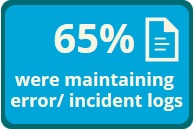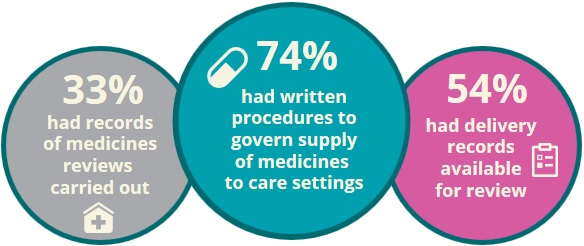Inspection Findings 2015
PSI inspectors carry out routine/systems inspections with the aim of providing assurance that the main systems, staff and structures in place in pharmacies are in line with legislation and good pharmacy practice.
We provide an overview of the findings from these inspections each year. The compliance statistics are outlined under five key heading along with resources of use to pharmacists and pharmacy owners.
2015 Inspection Statistics
The findings from the 144 routine pharmacy inspections carried out in 2015 have been published and are available to read in full.
In particular, PSI Inspectors highlight three areas of non-compliance that raise concern on review of inspection findings in 2015.
1. Recording and Management of Errors

65% of pharmacies were keeping logs of error/incidents at the pharmacy, however the corrective actions implemented were not always recorded.
A pharmacy must have a clear, documented system for the management and recording of errors, including near misses. An error log should be completed for all errors made in the pharmacy, and all staff members involved should be informed of the error. Recording errors should not be used as a way to blame individuals, but rather to encourage an environment of openness and learning, so that procedures can be reviewed and amended, actions taken or practices changed to guard against similar errors happening again. The correct management of errors and near misses is important to ensure patient safety.
It should be noted that superintendent pharmacists have overall responsibility for error report management. A reminder of the importance of error recording, corrective actions and learnings can be found in PSI resources for Superintendent Pharmacists, which may be relevant to all pharmacists.
2. Emergency Supply of Prescription Only Medicines
The
emergency supply legislation is in place to allow supply, in the
absence of a valid prescription, to meet the immediate needs of a
patient when it is impractical for a prescription to be obtained.
Emergency supply must not be used on a regular and routine basis for reasons such as convenience, and the importance of regular attendance
and consultation with the prescriber and legal prescription requirements
should be communicated to patients.
Inspectors have found that emergency supplies are not always carried out in accordance with legislative requirements. Issues
include the supply of controlled drugs, supplying a quantity of medicines that
exceeds what is permitted under emergency supply provisions, or failure
to receive the original prescription from the prescriber within 72 hours of making the supply.
We encourage pharmacists to
review their pharmacy’s procedures for the emergency supply of
prescription only medicines to ensure all requirements are being met,
and to make use of these materials:
3. Supply of Medicines to Patients in Nursing Homes and Residential Care Settings

The major areas of non-compliance concerning the supply of medicines to patients in nursing homes and residential care homes relate to the failure to maintain documented procedures and records at the pharmacy. All pharmacies providing pharmaceutical services to patients in nursing homes and residential care settings are reminded to review their procedures, in conjunction with the PSI Guidance to ensure all requirements are being met.
An overview of inspection findings are available for:
All legislation is available at www.irishstatutebook.ie and all PSI guidance is available at www.psi.ie. Systems inspections are carried out under Section 67 of the Pharmacy Act 2007.
Related Content:
Domperidone Test Purchases
The PSI carried out mystery shopper exercises in 2014 and 2015 to check whether non-prescription medicines containing domperidone were being supplied in accordance with the updated marketing authorisation for domperidone and PSI Guidance. The results of this compliance exercise and recommendations to pharmacists can be read here.